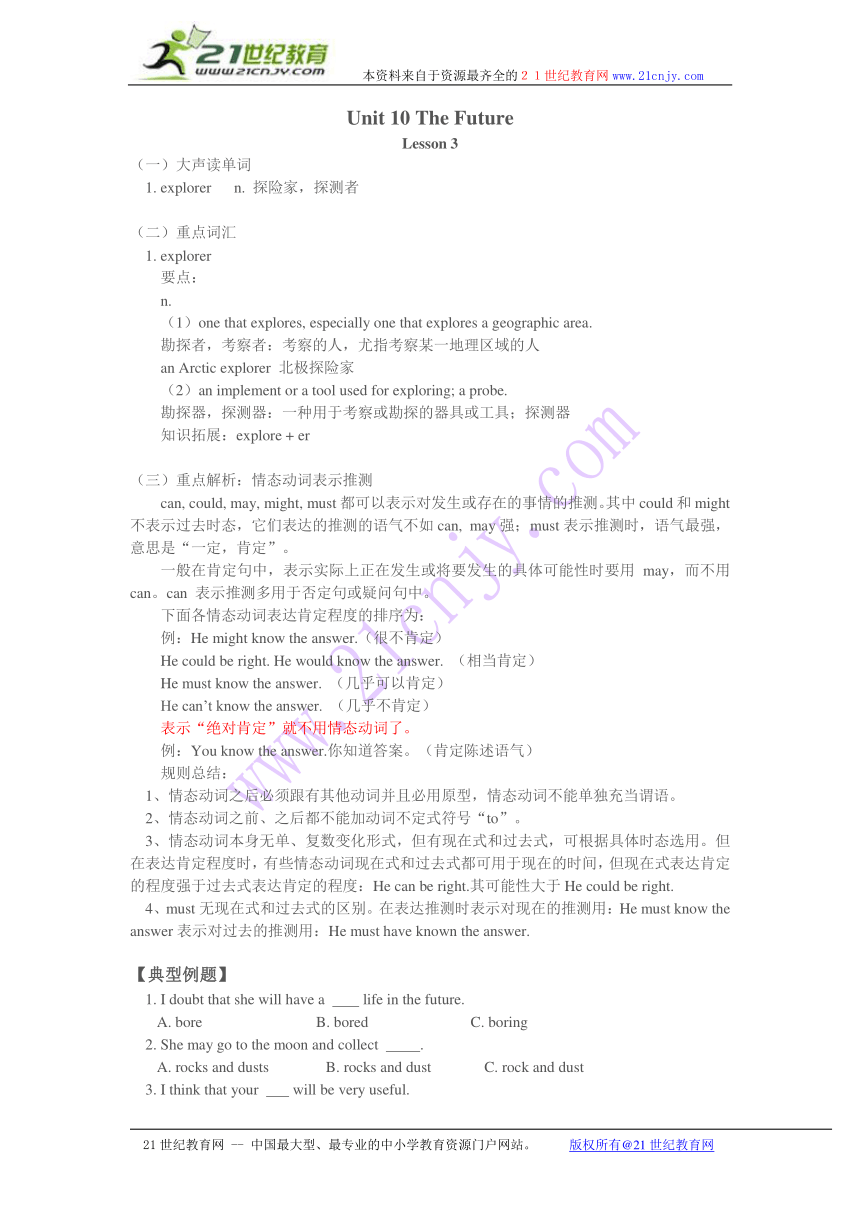英语:unit 10 the future lesson 3学案(教科版八年级下)
文档属性
| 名称 | 英语:unit 10 the future lesson 3学案(教科版八年级下) |  | |
| 格式 | rar | ||
| 文件大小 | 11.8KB | ||
| 资源类型 | 教案 | ||
| 版本资源 | 教科版 | ||
| 科目 | 英语 | ||
| 更新时间 | 2010-01-21 13:21:00 | ||
图片预览

文档简介
本资料来自于资源最齐全的21世纪教育网www.21cnjy.com
Unit 10 The Future
Lesson 3
(一)大声读单词
1. explorer n. 探险家,探测者
(二)重点词汇
1. explorer
要点:
n.
(1)one that explores, especially one that explores a geographic area.
勘探者,考察者:考察的人,尤指考察某一地理区域的人
an Arctic explorer 北极探险家
(2)an implement or a tool used for exploring; a probe.
勘探器,探测器:一种用于考察或勘探的器具或工具;探测器
知识拓展:explore + er
(三)重点解析:情态动词表示推测
can, could, may, might, must都可以表示对发生或存在的事情的推测。其中could和might不表示过去时态,它们表达的推测的语气不如can, may强;must表示推测时,语气最强,意思是“一定,肯定”。
一般在肯定句中,表示实际上正在发生或将要发生的具体可能性时要用may,而不用can。can 表示推测多用于否定句或疑问句中。
下面各情态动词表达肯定程度的排序为:
例:He might know the answer.(很不肯定)
He could be right. He would know the answer. (相当肯定)
He must know the answer. (几乎可以肯定)
He can’t know the answer. (几乎不肯定)
表示“绝对肯定”就不用情态动词了。
例:You know the answer.你知道答案。(肯定陈述语气)
规则总结:
1、情态动词之后必须跟有其他动词并且必用原型,情态动词不能单独充当谓语。
2、情态动词之前、之后都不能加动词不定式符号“to”。
3、情态动词本身无单、复数变化形式,但有现在式和过去式,可根据具体时态选用。但在表达肯定程度时,有些情态动词现在式和过去式都可用于现在的时间,但现在式表达肯定的程度强于过去式表达肯定的程度:He can be right.其可能性大于He could be right.
4、must无现在式和过去式的区别。在表达推测时表示对现在的推测用:He must know the answer表示对过去的推测用:He must have known the answer.
【典型例题】
1. I doubt that she will have a life in the future.
A. bore B. bored C. boring
2. She may go to the moon and collect .
A. rocks and dusts B. rocks and dust C. rock and dust
3. I think that your will be very useful.
A. invent B. invention C. inventor
4. The had many .
A. explorer, adventures B. explore, adventure C. explorer, adventure
5. Which stress of the following words is different
A. return B. exercise C. design
[参考答案]1. C 2. B 3. B 4. A 5. B
21世纪教育网 -- 中国最大型、最专业的中小学教育资源门户网站。 版权所有@21世纪教育网
Unit 10 The Future
Lesson 3
(一)大声读单词
1. explorer n. 探险家,探测者
(二)重点词汇
1. explorer
要点:
n.
(1)one that explores, especially one that explores a geographic area.
勘探者,考察者:考察的人,尤指考察某一地理区域的人
an Arctic explorer 北极探险家
(2)an implement or a tool used for exploring; a probe.
勘探器,探测器:一种用于考察或勘探的器具或工具;探测器
知识拓展:explore + er
(三)重点解析:情态动词表示推测
can, could, may, might, must都可以表示对发生或存在的事情的推测。其中could和might不表示过去时态,它们表达的推测的语气不如can, may强;must表示推测时,语气最强,意思是“一定,肯定”。
一般在肯定句中,表示实际上正在发生或将要发生的具体可能性时要用may,而不用can。can 表示推测多用于否定句或疑问句中。
下面各情态动词表达肯定程度的排序为:
例:He might know the answer.(很不肯定)
He could be right. He would know the answer. (相当肯定)
He must know the answer. (几乎可以肯定)
He can’t know the answer. (几乎不肯定)
表示“绝对肯定”就不用情态动词了。
例:You know the answer.你知道答案。(肯定陈述语气)
规则总结:
1、情态动词之后必须跟有其他动词并且必用原型,情态动词不能单独充当谓语。
2、情态动词之前、之后都不能加动词不定式符号“to”。
3、情态动词本身无单、复数变化形式,但有现在式和过去式,可根据具体时态选用。但在表达肯定程度时,有些情态动词现在式和过去式都可用于现在的时间,但现在式表达肯定的程度强于过去式表达肯定的程度:He can be right.其可能性大于He could be right.
4、must无现在式和过去式的区别。在表达推测时表示对现在的推测用:He must know the answer表示对过去的推测用:He must have known the answer.
【典型例题】
1. I doubt that she will have a life in the future.
A. bore B. bored C. boring
2. She may go to the moon and collect .
A. rocks and dusts B. rocks and dust C. rock and dust
3. I think that your will be very useful.
A. invent B. invention C. inventor
4. The had many .
A. explorer, adventures B. explore, adventure C. explorer, adventure
5. Which stress of the following words is different
A. return B. exercise C. design
[参考答案]1. C 2. B 3. B 4. A 5. B
21世纪教育网 -- 中国最大型、最专业的中小学教育资源门户网站。 版权所有@21世纪教育网
同课章节目录
